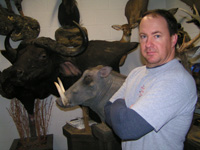Editorial
Front Page - Friday, January 7, 2011
Award winning taxidermist reveals the mysteries of his trade
David Laprad
 Michael Shipman is a certified taxidermist operating out of Cohutta, Ga. Known for quality work, he’s mounted dozens of species of animals and birds from around the world, and regularly takes classes and seeks out mentors who can help him raise the level of his trade.
- David Laprad
Michael Shipman is a certified taxidermist operating out of Cohutta, Ga. Known for quality work, he’s mounted dozens of species of animals and birds from around the world, and regularly takes classes and seeks out mentors who can help him raise the level of his trade.
- David Laprad
A bobcat crouches on a rock behind Michael Shipman, poised to spring forward and snag its morning meal. A vicious-looking warthog has turned its eyes toward Shipman, ready to gore the man with its tusks if the bobcat hesitates. A nearby white tail deer remains as still as a statue, trying to stay off the menu.
Shipman stands in the middle of the unfolding drama, not the least bit worried about ending up as the main course in a feast for the Who’s Who of the Wild Kingdom. That’s because the creatures that surround him have already breathed their last breath.
As a taxidermist, Shipman is more concerned with preserving the appearance and character of the animals he mounts.
“I’ve had people ask me if the eyes are real. The only things that are real are the skin and the antlers,” he says.
The eyes of the animals that grace the walls of Shipman’s Cohutta, Ga., shop are actually made of glass, while the skins were fitted over urethane foam forms Shipman ordered from a vendor. From his vantage point, he can see wood ducks, pheasants, a mule deer, a zebra, a bear, a blue and a black wildebeest, a cape buffalo, a red stag, a Merriam turkey and more.
When a creature comes to Shipman, he skins it and cleans its hide, which he sends off to be tanned. When the hide is returned, it’s hard and caked in salt. Shipman soaks it to return it to a pliable state and then begins the process of fitting it over the form.
Once he adds his finishing touches, the end result is a still life that looks remarkably alive. Noses on mammals look moist and have small bumps, turkeys sport bright colors, and pheasants display beautiful plumage. Judging by the gallery of his work, Shipman has a remarkable eye for detail.
“Animals lose their color when they dry, so I brighten them up with paint. I also rebuild the insides of their nostrils with epoxy. Sometimes, the lips shrink, and I’ll rebuild those, too,” he says.
While working on an animal, Shipman refers to an extensive library of photographs. He can re-create any realistic pose from a picture or drawing as well as add surrounding detail to create a dramatic scene. Whether he’s mounted only the head of an animal or the entire body, the end result is a work of art a hunter can proudly display.
Shipman’s clients are not all local boys and girls. Once positive word of mouth about his work started to spread, he attracted clients who’d hunted in places as remote as Africa, Argentina, Australia, Mongolia, New Zealand and Russia. To be able to process animals from other countries, Shipman had to obtain approval from the U.S. Department of Agriculture.
While each of his clients has his or her own favorite hunting ground and prey of choice, two things they all have in common are patience and the money to have their trophies mounted. Shipman says it can take anywhere from six to 18 months to complete a job, while the cost can range from a few hundred dollars to well north of $1,000, depending on the animal and the complexity of the work.
Like any tradesman worth his salt, Shipman has honed his skills over time and continues to improve his techniques. When he
first became interested in taxidermy, he read about how to do
it and practiced on a few animals.
Although Shipman’s first few tries were less than successful, his abilities grew to the point where he was able to enter competitions and win awards. Today, he’s certified with the Georgia Taxidermist Association, and regularly takes classes and seeks out mentors who can help him raise the level of his trade.
“Two months ago, I spent a week with the guy who won the [2009] world championship. I mount a pretty good turkey, but he showed me things that will really bump it up as far as being able to compete. We went over painting techniques and anatomy, which was basically what a turkey’s wings can and can’t do, and what its feet can and can’t do,” he says.
As Shipman picks up the head of a bear he’s turning into a rug, he looks like Hamlet holding the skull of Horatio. While the bear returns his gaze with his new eyes, Shipman talks about how he insists on doing every step of the mounting process in the best possible way, which means he doesn’t dry preserve animals, even though it would be less expensive for his clients.
Shipman says he became a taxidermist because he loves animals, and is pleased to be making a living doing something he enjoys. An antelope, it’s face full of pins and its ears held up with clothespins while its skin dries, looks on in silent agreement.
For more, visit www.shipmanstaxidermy.com.
|
|